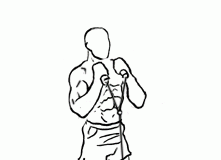Last Updated on November 6, 2023
These issues are simple to resolve. Let’s address some of the most common issues that may be preventing you from achieving your biceps goals.
Immediately after lifting a dumbbell for the first time, most gym rats hope their T-shirts will be blown away by a pair of cannonball bis someday.
Most trainees understand that developing a formidable set of guns is more of a journey than a quick trip, and they will reach their destination sooner if they focus on proper technique when performing dumbbell biceps curls. According to Men’s Health fitness director Ebenezer Samuel, C.S.C.S., most lifters make a host of little errors the first time they do biceps curls—poor form and mechanics being among them—which can impede early gains and prevent them from achieving the arm pump they desire.
Fortunately, most of these issues are simple to resolve. Let’s address some of the most common issues that may be preventing you from achieving the biceps you want.
Avoid these three beginner mistakes.
One major mistake people make is focusing too much on their shoulders.
The more repetitions you do during a set of bis curls, the more likely you are to shift your shoulders in order to help propel the movement. As a result, your biceps receive less emphasis.
The trick to avoiding this error is to pin your elbows to your sides and move at the joint only. Whether you use barbells, dumbbells, cables, or any other type of curl, the goal is to focus on isolating the biceps muscle. You won’t be able to eliminate shoulder involvement with every rep (you’ll eventually become fatigued), but keeping your elbows tight will help your biceps do the work for the majority of reps.
Using too much wrist flexion is a common mistake.
Keeping your wrists in a nice, neutral position each time we curl will create the most challenge for our biceps.
The issue with incorporating wrist flexion into a biceps curl, as opposed to keeping the wrist straight, is that you’ll use the wrist and forearm muscles to initiate the movement, which will keep the biceps under tension throughout the lift. Consequently, when the wrist is flexed, the lever that the biceps must work against is decreased, resulting in a less demanding exercise and a lessening in the stimulus that promotes muscle growth.
Maintain a neutral wrist position throughout the exercise to avoid wrist flexion. Only the elbow should flex during a curl; the wrist should remain neutral.
The third biceps-building mistake is being lazy with supination.
Our biceps perform two actions: bending at the elbow and supinating or turning the palm upward. To emphasize the muscle squeeze, both actions should be performed efficiently with each repetition.
Make sure that your palms are shifting to the ceiling early in each curl rep if you want to get the most out of your curl. Otherwise, you’re not doing it right.







